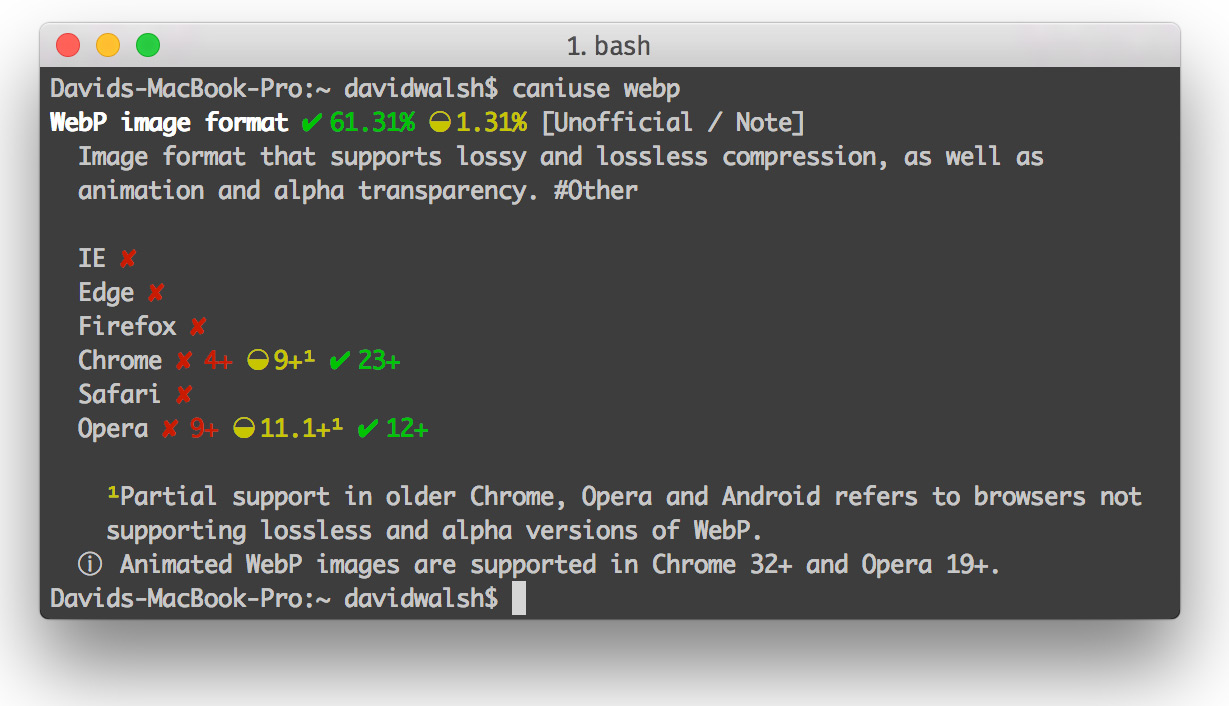CanIUse Command Line
Every front-end developer should be well acquainted with CanIUse, the website that lets you view browser support for browser features. When people criticize my blog posts for not detailing browser support for features within the post, I tell them to check CanIUse: always up to date, unlike posts on any blog. While I know to use the CanIUse website, I recently found out that Sam Gentle has an accompanying Node.js CanIUse module for looking up browser support.
To install the utility, use a typical npm install command:
# Install globally for less hassle
npm install -g caniuse-cmd
With the caniuse command available, you can look up feature support from the command line:


The display of results is pretty and it provides a listing of different matching features if the lookup is vague. And because we can get this information in an automated way, you can probably write a decent scraper with cURL and other tools.
![Interview with a Pornhub Web Developer]()
Regardless of your stance on pornography, it would be impossible to deny the massive impact the adult website industry has had on pushing the web forward. From pushing the browser's video limits to pushing ads through WebSocket so ad blockers don't detect them, you have...
![How to Create a RetroPie on Raspberry Pi – Graphical Guide]()
Today we get to play amazing games on our super powered game consoles, PCs, VR headsets, and even mobile devices. While I enjoy playing new games these days, I do long for the retro gaming systems I had when I was a kid: the original Nintendo...
![Fancy FAQs with MooTools Sliders: Version 2]()
A little over a year ago I authored a post titled Fancy FAQs with MooTools Sliders. My post detailed a method of taking boring FAQs and making them more robust using the world's best JavaScript framework: MooTools. I've taken some time to...
![Web Audio API]()
The Web Audio API allows developers to load and decode audio on demand using JavaScript. The more I evaluate awesome games for Firefox OS TVs, the more I get to learn about these APIs that I normally wouldn't touch. The following is a very basic introduction to the WebAudio API...







I need to get this hooked up to be an email responder bot! “Hey Steve does
${browserX}support${featureY}?” => auto respond ;-)How about just adding canIuse as a search engine to your browser, like so http://caniuse.com/#search=%s?
Simply typing “c webp” into my browser gives me even nicer formatted results.
Sadly the output is not very useful for automated processing. It would’ve been nice if this could be implemented in a gulp-task, scanning CSS for a defined set of supported browsers, and if a css-declaration wasn’t supported it would throw an error.
But as your example of ‘transform’ shows, it returns things like JPEG2000, so output parsing is required and tedious. Plus it seems that there is no option to print a simple boolean instead of fancy ticks and crosses.
There’s also this package available via npm.
https://www.npmjs.com/package/caniuse-api
Perhaps this would work better for that task.
Definitely an interesting article about this new npm tool, useful for those who like command line better then gui.